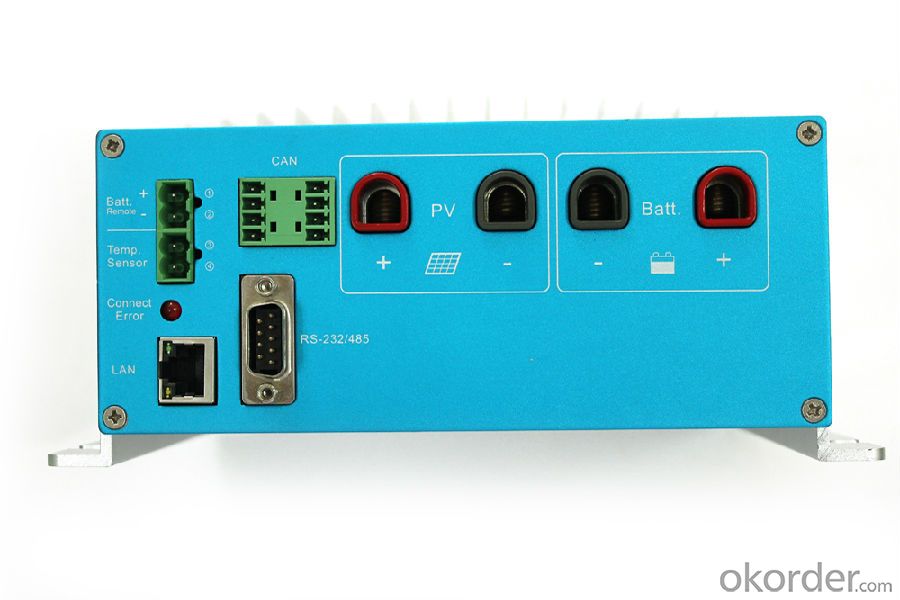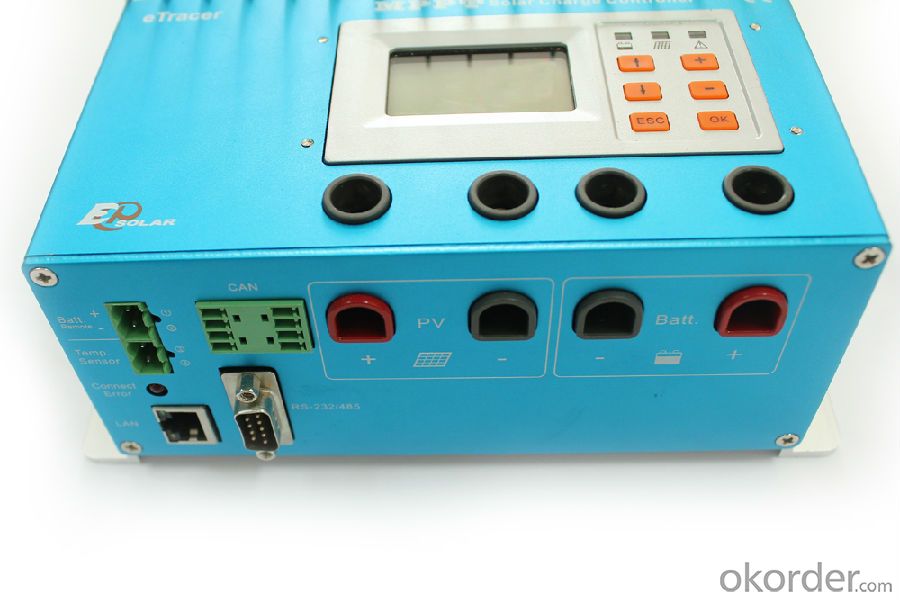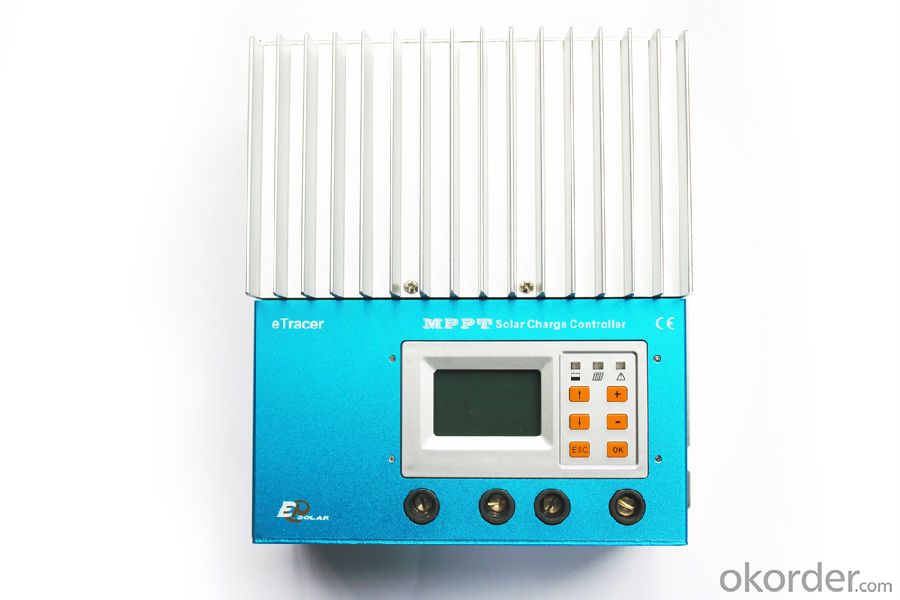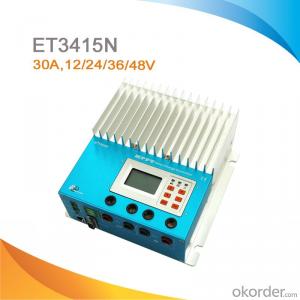MPPT Solar Panel Charge Controller 30A,12/24/36/48V,ET3415N
OKorder Service Pledge
OKorder Financial Service
You Might Also Like
Specifications
MPPT charge controller
Maximum power point tracker
temperature compensation
LCD display
Communicate with PC
Features:
·12/24/36/48V auto work
·Advanced MPPT technology
·Several seconds tracking speed
·High Tracking efficiency of 99%
·Multiphase synchronous rectification technology
·Peak conversion efficiency of 98%
·DSP&ARM processors architecture ensures high speed and performance
·Gel, Sealed, Flooded battery option
·Max. 450 days data logging by connection to PC
·Multifunction LCD displays system data and status
·Three kinds of communication ports :RS232, CAN BUS and Ethernet
·Three stages charging optimizes battery performance
·Software update by users
Electronic Protections:
·PV short circuit protection
·PV reverse polarity protection
·PV overvoltage alarm protection
·PV over current protection
·Battery overcharge protection
·Battery over discharge protection
·Battery reverse polarity protection
·Overheating protection
Specification:
Model | ET3415N | ET4415N | ET6415N |
Rated system voltage | 12V/24V /36V/48V auto work | ||
Rated battery current | 30A | 45A | 60A |
Max. PV open circuit voltage | 150V | ||
Voltage range | 8~72V | ||
Max.PV input power | 400W (12V) | 600W (12V) | 800W (12V) |
800W (24V) | 1200W (24V) | 1600W (24V) | |
1200W (36V) | 1800W (36V) | 2400W (36V) | |
1600W (48V) | 2400W (48V) | 3200W (48V) | |
Self-consumption | 1.4~2.2W | ||
Grounding | Negative | ||
Dimension | 231x203x105mm | 285x203x105mm | 285x203x121mm |
Terminal | 35mm2 | 35mm2 | 35mm2 |
Net Weight | 4.1kg | 4.4kg | 5.0kg |
Working temperature | -25℃~+55℃ | ||
Storage temperature range | -30℃~+85℃ | ||
Humidity | 10%-90% NC | ||
Enclosure | IP20 | ||
Altitude | ≤3000m | ||



FAQ:
Q1. What is the voltage?
A1. Our 45/60A solar charge controller is 12/24/36/48V auto work.
Q2. What is the difference between MPPT&PWM?
A2. MPPT has higher efficiency, it can track the max power point and won't waste energy.
Q3. What is the efficiency of the MPPT controller?
A3. MPPT>99%, peak conversion efficiency>98%.
Q4. What is the waranty of product?
A4. 12 months.
Q5. What protection does your MPPT controller have?
A5. PV array short circuit, PV reverse polarity, Battery reverse polarity, Over charging, Output short circuit.
- Q:How do I ensure proper grounding of a solar controller system?
- To ensure proper grounding of a solar controller system, you need to follow a few guidelines. First, ensure that the grounding conductor is properly sized and made of copper or another suitable material. It should be connected to the grounding electrode system of your building or property. Additionally, make sure to bond all metal components of the system, including the solar panels, controller, and wiring, to the grounding conductor. This helps prevent electrical shock hazards and protects the system from lightning strikes. Lastly, regularly inspect and maintain the grounding system to ensure its effectiveness over time.
- Q:How does a solar controller handle power surges from the solar panels?
- The flow of power from solar panels to the battery bank or electrical grid is regulated by a solar controller, which is a crucial component in a solar power system. Safeguarding the system is a crucial role played by a solar controller when it comes to dealing with power surges from the solar panels. Power surges can occur due to various reasons like sudden changes in weather conditions, fluctuations in solar radiation, or issues with the solar panel itself. If not handled properly, these surges can potentially damage the system and its components. To handle power surges, a solar controller usually includes several protective mechanisms. One of its primary functions is to prevent overcharging of the battery bank. Whenever a power surge occurs, the solar controller detects the excess voltage and current and limits the charging rate to ensure that the battery does not get overcharged. This helps in maintaining the battery's health and prolonging its lifespan. Moreover, solar controllers often incorporate devices such as surge protectors or voltage clamps for transient voltage suppression. These devices help in absorbing and diverting excessive voltage spikes away from the system, thereby preventing damage to the solar panels, controller, batteries, or other connected devices. In addition, some advanced solar controllers utilize Maximum Power Point Tracking (MPPT) technology. This technology optimizes the power output of the solar panels by dynamically adjusting the voltage and current, even during power surges. MPPT controllers enhance the system's efficiency while minimizing the impact of power fluctuations. In conclusion, a solar controller regulates the charging rate to prevent overcharging, incorporates surge protection devices, and utilizes MPPT technology to optimize power output when handling power surges from the solar panels. These protective features ensure system stability, protect components from damage, and maximize the efficiency of the solar power system.
- Q:What is the installation process for a solar controller?
- The installation process for a solar controller typically involves a few key steps. First, you need to determine the appropriate location for the controller, ensuring it is easily accessible and protected from extreme weather conditions. Next, you will need to connect the solar panels to the controller, ensuring the positive and negative terminals are correctly aligned. After that, you will need to connect the battery to the controller, again ensuring proper polarity. Finally, you may need to configure the settings on the controller, such as battery type and charging parameters, according to the manufacturer's instructions. It's important to follow the specific guidelines provided by the manufacturer to ensure a safe and efficient installation.
- Q:What is the maximum efficiency rating of a solar controller?
- The maximum efficiency rating of a solar controller typically ranges between 95% and 99%, with some advanced models even reaching up to 99.9% efficiency.
- Q:Can a solar controller be used in off-grid applications?
- Yes, a solar controller can be used in off-grid applications. In fact, it is an essential component of off-grid solar systems as it helps regulate the charging and discharging of the battery bank, ensuring optimal performance and preventing overcharging or deep discharging. The solar controller also helps protect the batteries from damage caused by various factors such as excessive voltage, temperature fluctuations, and overcurrent.
- Q:What is the maximum power rating that a solar controller can handle?
- The maximum power rating that a solar controller can handle depends on the specific model and manufacturer. Generally, solar controllers are designed to handle a certain maximum wattage or current in order to regulate the energy flow from the solar panels to the battery bank. This maximum power rating is typically specified by the manufacturer and can vary greatly. It is important to choose a solar controller that can handle the maximum power output of the solar panels being used. Exceeding the maximum power rating of a solar controller can lead to overheating and potential damage to the controller. Therefore, it is crucial to consult the specifications provided by the manufacturer or seek professional advice to determine the appropriate solar controller for a given solar panel system.
- Q:What is the role of a battery capacity monitor in a solar controller?
- The role of a battery capacity monitor in a solar controller is to accurately measure and report the level of charge in the battery bank. It helps to prevent overcharging or over-discharging of the batteries, which can lead to reduced lifespan and performance. The monitor allows the solar controller to efficiently regulate the charging and discharging process, ensuring that the batteries are maintained at optimal levels for maximum efficiency and longevity.
- Q:How can I monitor the performance of my solar controller?
- To monitor the performance of your solar controller, you can follow these steps: 1. Check the display: Most solar controllers have a built-in display that shows important information such as battery voltage, charging current, and load status. Regularly monitor this display to ensure that these values are within the desired range. 2. Use a multimeter: Connect a multimeter to the solar controller's terminals to measure the voltage and current being generated by the solar panels. This will help you assess if the solar panels are functioning optimally. 3. Monitor battery status: Keep an eye on the battery voltage and charge level. If the voltage drops below a certain threshold or the battery remains undercharged, it may indicate a problem with the solar controller's charging functionality. 4. Observe load performance: If your solar controller is connected to a load such as lights or appliances, monitor their performance. Any issues like flickering lights or devices not functioning properly could indicate a problem with the solar controller. 5. Analyze historical data: Many advanced solar controllers have data logging capabilities. Reviewing historical data, such as energy production and battery charging patterns, can help identify any long-term performance issues or trends. 6. Consult the user manual: Always refer to the user manual provided by the manufacturer for specific monitoring instructions and troubleshooting tips for your solar controller model. By regularly monitoring these aspects, you can ensure that your solar controller is operating efficiently and address any performance issues promptly.
- Q:Can a solar controller be used with a solar-powered billboard?
- Yes, a solar controller can be used with a solar-powered billboard. A solar controller is designed to regulate the flow of electricity from the solar panels to the battery storage system, ensuring optimal charging and preventing overcharging. In the case of a solar-powered billboard, the solar controller would help manage the power generated by the solar panels, ensuring efficient operation and storage of excess energy for use during low-light conditions or at night.
- Q:How does a solar controller prevent damage from overloading of the load?
- A solar controller prevents damage from overloading of the load by continuously monitoring the current flowing through the system and regulating it to a safe level. It does this by automatically adjusting the voltage and current supplied to the load, ensuring that it does not exceed the controller's maximum capacity. This helps protect the load from excessive power and prevents any potential damage that could occur due to overloading.
1. Manufacturer Overview |
|
|---|---|
| Location | |
| Year Established | |
| Annual Output Value | |
| Main Markets | |
| Company Certifications | |
2. Manufacturer Certificates |
|
|---|---|
| a) Certification Name | |
| Range | |
| Reference | |
| Validity Period | |
3. Manufacturer Capability |
|
|---|---|
| a)Trade Capacity | |
| Nearest Port | |
| Export Percentage | |
| No.of Employees in Trade Department | |
| Language Spoken: | |
| b)Factory Information | |
| Factory Size: | |
| No. of Production Lines | |
| Contract Manufacturing | |
| Product Price Range | |
Send your message to us
MPPT Solar Panel Charge Controller 30A,12/24/36/48V,ET3415N
OKorder Service Pledge
OKorder Financial Service
Similar products
New products
Hot products
Hot Searches
Related keywords































